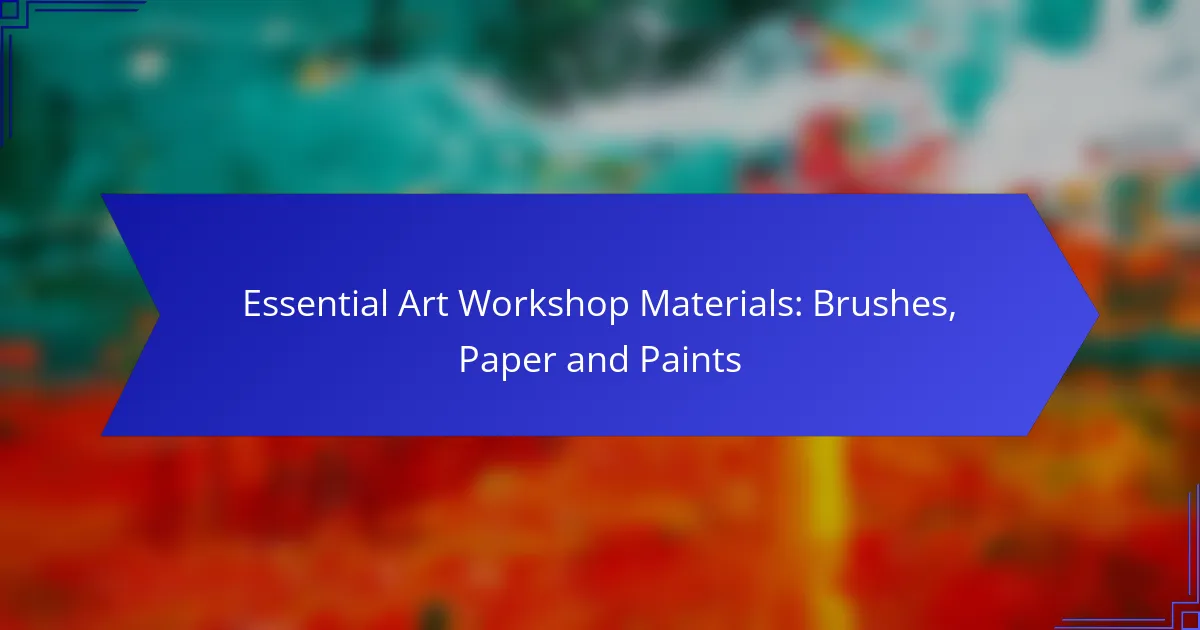In any art workshop, having the right materials is essential for fostering creativity and achieving desired results. Brushes, paper, and paints each play a crucial role in the artistic process, influencing both technique and outcome. Selecting the appropriate brushes enhances your painting experience, while choosing the right paper ensures durability and effect. Additionally, the type of paint used can cater to various skill levels and artistic preferences, making it vital to consider these elements carefully.

What are the essential brushes for art workshops?
The essential brushes for art workshops include a variety of types designed for specific techniques and effects. Selecting the right brushes can significantly enhance your painting experience and outcomes.
Round brushes for detail work
Round brushes are ideal for intricate detail work due to their pointed tips. They allow artists to create fine lines, delicate strokes, and precise details, making them a staple in any art workshop.
When choosing round brushes, consider sizes ranging from small (around 0-2) for fine details to larger sizes (up to 12) for broader strokes. A good quality round brush will hold its shape and point well, ensuring consistent results.
Flat brushes for broad strokes
Flat brushes are perfect for making broad strokes and filling in large areas of color. Their square edges enable artists to create sharp lines and defined shapes, which is essential for landscapes and abstract work.
Look for flat brushes in various widths, typically from 1 inch to 2 inches, depending on your project needs. A flat brush can also be used for blending colors, making it a versatile tool in your kit.
Filbert brushes for versatility
Filbert brushes combine the features of round and flat brushes, making them highly versatile. Their oval shape allows for both detailed work and broader strokes, making them suitable for a variety of painting styles.
Filbert brushes are available in different sizes, typically ranging from small (size 2) to large (size 12). They are particularly effective for softening edges and creating rounded shapes, which is useful in portrait painting.
Fan brushes for texture
Fan brushes are designed with bristles arranged in a fan shape, making them excellent for creating texture in your artwork. They can be used to simulate natural elements like grass, fur, or foliage.
When using a fan brush, experiment with different pressures and angles to achieve various effects. Sizes typically range from small (size 4) to large (size 10), allowing for both fine and broader textural applications.
Watercolor brushes for fluid mediums
Watercolor brushes are specifically designed for use with water-based paints. They often feature softer bristles that hold water and pigment well, allowing for smooth washes and fluid strokes.
Common types include round and flat watercolor brushes, with sizes ranging from small (size 0) for detail to larger sizes (size 12 or more) for washes. Ensure the brushes are made from high-quality synthetic or natural hair to achieve the best results in your watercolor projects.

How to choose the right paper for painting?
Choosing the right paper for painting is crucial for achieving the desired effects and durability of your artwork. Consider the type of paint you will use, the techniques you plan to employ, and the texture and weight of the paper.
Watercolor paper for wet techniques
Watercolor paper is specifically designed to handle the application of water-based paints without warping or tearing. Look for papers that are 200 gsm or heavier, as they can absorb water effectively and maintain their integrity. Cold-pressed (noted as “rough”) paper has a textured surface that enhances the paint’s flow, while hot-pressed (or “smooth”) paper is ideal for detailed work.
When selecting watercolor paper, consider the grain and finish. A rough texture is excellent for expressive washes, while a smooth finish is better for fine details. Brands like Arches and Fabriano offer high-quality options that artists often prefer.
Acrylic paper for mixed media
Acrylic paper is designed to withstand the heavy application of acrylic paints and other mixed media materials. This type of paper typically features a weight of at least 250 gsm, which helps prevent warping and allows for layering techniques. Look for papers with a textured surface to enhance the adhesion of paint.
When using acrylic paper, consider its compatibility with other media, such as pastels or ink. Some brands, like Canson and Strathmore, provide versatile options that accommodate various techniques, making them suitable for mixed media projects.
Canvas sheets for oil painting
Canvas sheets are an excellent choice for oil painting, providing a durable surface that can handle the heavy application of oil paints. These sheets are typically pre-stretched and primed, ready for use. Look for canvas sheets with a weight of around 300 gsm for optimal performance.
When selecting canvas sheets, consider the texture and priming. A fine texture is suitable for detailed work, while a coarse texture can add depth to your brush strokes. Brands like Fredrix and Masterpiece offer reliable options for oil painters.
Sketch paper for preliminary work
Sketch paper is ideal for preliminary work, allowing artists to experiment with ideas before committing to final pieces. This type of paper is usually lightweight, around 90-120 gsm, making it easy to carry and use for quick sketches. It is often uncoated, allowing for a variety of drawing mediums.
When choosing sketch paper, consider the texture and color. A smooth surface is great for pencil and ink, while a textured surface works well with charcoal and pastels. Brands like Strathmore and Canson offer a range of sketch pads that cater to different artistic needs.

What types of paints are best for workshops?
The best paints for workshops depend on the skill level of participants and the desired outcomes. Acrylic, watercolor, oil, and gouache each offer unique properties that cater to different artistic techniques and preferences.
Acrylic paints for beginners
Acrylic paints are versatile and user-friendly, making them ideal for beginners. They dry quickly and can be used on various surfaces, including canvas and paper, which allows for experimentation without long wait times.
These paints are water-soluble when wet but become water-resistant once dry, providing flexibility in techniques. A basic set of primary colors can be mixed to create a wide range of shades, making them cost-effective for workshops.
Watercolor paints for transparency
Watercolor paints are known for their transparency and fluidity, allowing artists to create delicate washes and subtle gradients. They are best used on special watercolor paper that can absorb water without warping.
These paints require a different approach, as layering is essential to achieve depth. Beginners should start with a simple palette and practice techniques like wet-on-wet and wet-on-dry to understand how water interacts with pigment.
Oil paints for rich textures
Oil paints are favored for their rich colors and ability to create texture. They dry slowly, allowing artists to blend colors and work on details over extended periods. This characteristic is beneficial for those looking to achieve depth in their work.
However, oil paints require specific mediums and solvents for thinning and cleaning, which can be a consideration for workshops. Participants should be aware of ventilation and safety when using these materials.
Gouache for opacity and vibrancy
Gouache is an opaque water-based paint that offers vibrant colors and a matte finish. It combines the properties of watercolor and acrylic, allowing for both transparency and solid coverage, making it suitable for various styles.
Gouache can be reactivated with water, enabling artists to make adjustments even after the paint has dried. This feature is particularly useful in workshops where experimentation is encouraged. A basic set of gouache paints can provide a wide range of creative possibilities.

What are the key factors in selecting art materials?
When selecting art materials, consider quality, compatibility with your techniques, and brand reputation. These factors can significantly impact your creative process and the final outcome of your artwork.
Quality vs. affordability
Quality materials often yield better results, but they can come at a higher price. Striking a balance between quality and affordability is crucial; look for brands that offer good performance without breaking the bank.
For example, student-grade paints and brushes can be a cost-effective choice for beginners, while professional-grade options are ideal for serious artists. Consider investing in high-quality brushes and paints for projects that require precision and detail.
Compatibility with techniques
Different art techniques require specific materials to achieve desired effects. For instance, watercolor paints work best on specialized watercolor paper, while acrylics can be used on a variety of surfaces.
Before purchasing, assess the techniques you plan to use. If you’re focusing on mixed media, ensure your materials are compatible with each other to avoid issues like peeling or fading.
Brand reputation and reviews
Choosing reputable brands can save you time and frustration. Brands with positive reviews are often more reliable in terms of quality and performance.
Research online reviews and artist forums to gather insights about different products. Look for feedback on durability, ease of use, and color accuracy to make informed decisions.
